Relationships between tables in Access
In this article, go with TipsMake.com to learn more about how to establish a relationship.The nn relationship is the relation between two tables, a record of table A can have multiple records matching in table B and vice versa.
To create such a relationship, define the third table, called a join table, with the primary key including foreign keys from both Table A and Table B to divide the nn relationship into two 1-n relationships. .
Continuing with the examples in the previous tutorial, we added a tblTacgia table and a link table tblTacgiaNoi. The Author table includes the schools TacgiaID, Ten, Ho, Diachi, Dienthoai, Email, Ngaysinh.

Often an author will work with many projects, as well as a project that can have many authors working together. As in the previous tutorials, the tblDuAn table also has an author field, so we will create a separate table that includes information about the author. So, we don't need this field in the Project table anymore.

Choose Tacgia school , press the delete button and you will see the following message.

Click Yes .
Now we will create a link board. This connector has two foreign keys as follows:
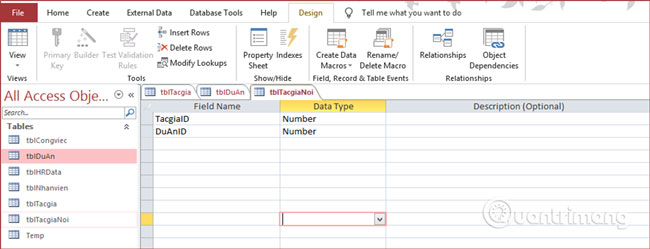
These foreign key fields will be primary keys from both tables tblTg and tblDuAn.
To create multiple keys in Access, select both of these fields, go to the Design tab , click Primary Key, the selected fields will become keys.
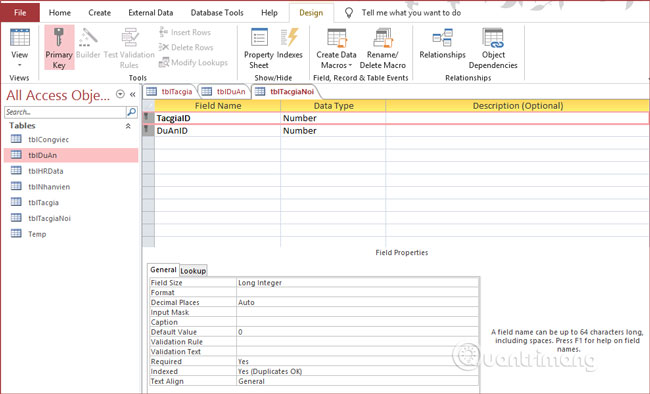
Save the table with the name tblTacgiaNoi.
Next, go to the Relationship in the Design tab to create a relationship by clicking Show Table.

Select the tblDuAn, tblTacgia and tblTacgiaNoi tables, click Add to add all three tables to the desktop and close the Show Table dialog box .

Using the mouse to click and hold the TacgiaID field in tblTacgia table , drag to the TacgiaID field you want to connect to the table tblTacgiaNoi. When you release the mouse, Access opens the Edit Relationships window . Note, the relationship that is creating Access will be considered a 1-n relationship. Click the Cascade Update box and click Create:
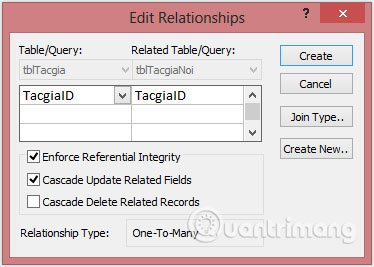
Result:
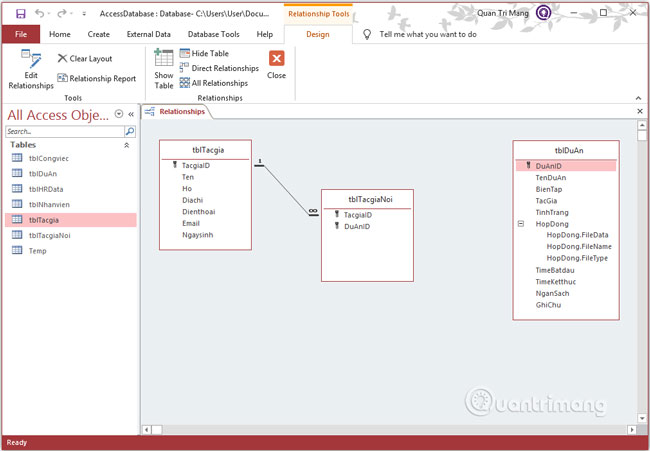
Next, drag the DuAnID field from the tblDuAn table to the DuAnID field of the tableTableGoogle, and check the Enforce Referential Integrity box and Cascade Update Related Fields .
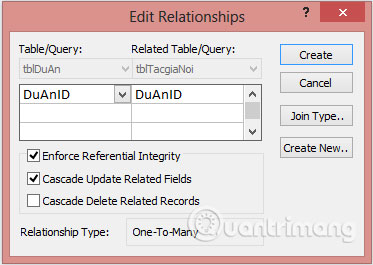
And this is the relationship we want to establish:
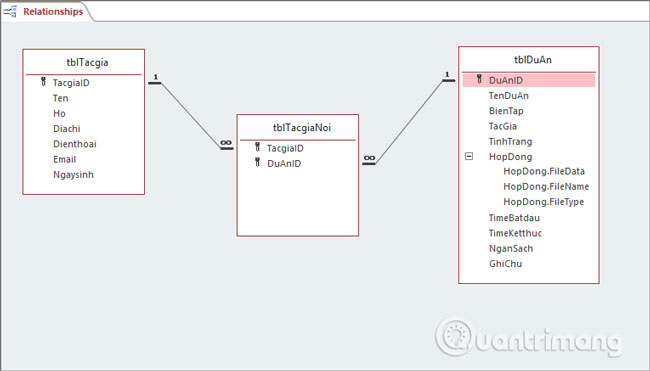
Previous article: 1-n relationship between tables in Access
Next lesson: Wildcard representation operator in Access
You should read it
- MS Access 2007 - Lesson 8: Establish relationships between tables
- 1-1 relationship between tables in ACCESS
- 1-n relationship between tables in Access
- Steps to create relationships between multiple tables using Data Model in Excel
- 14 questions you need to answer before starting a new relationship
- How to improve relationships in just 60 seconds?
- How to change relationships on Facebook
- 8 signs of your relationship will not go anywhere
May be interested
- MS Access 2003 - Lesson 39: Analyzing tables
 access includes a very powerful tool that you can use to analyze data in one or more tables.
access includes a very powerful tool that you can use to analyze data in one or more tables. - MS Access 2003 - Lesson 15: Create an initial table
 in this section, you are ready to create a table for the new database. in chapter 2, you used the table wizard to create tables easily. this not only shows that creating a table manually is difficult; but it is a sure way to understand the table.
in this section, you are ready to create a table for the new database. in chapter 2, you used the table wizard to create tables easily. this not only shows that creating a table manually is difficult; but it is a sure way to understand the table. - Work with data in Access 2016
 in the previous lesson, you became familiar with the access 2016 interface as well as the opening and closing of the basic database. this article will continue to go deeper into access 2016 around the content of working with data in access 2016.
in the previous lesson, you became familiar with the access 2016 interface as well as the opening and closing of the basic database. this article will continue to go deeper into access 2016 around the content of working with data in access 2016. - MS Access 2003 - Lesson 12: Working with a table
 you have learned how to create and design tables in access. and now it's time to learn how to manipulate all tables.
you have learned how to create and design tables in access. and now it's time to learn how to manipulate all tables. - Create data queries in Access 2016 from simple to complex
 the query allows to retrieve information from one or more tables based on the search conditions you defined. in this lesson, you will learn how to create queries on a simple table and query on multiple tables in access 2016.
the query allows to retrieve information from one or more tables based on the search conditions you defined. in this lesson, you will learn how to create queries on a simple table and query on multiple tables in access 2016. - How to Link Tables in Access
 microsoft access allows tables and databases to connect with each other. this capability can increase your efficiency and easily spread information that is required for multiple departments or reports. you can make changes in the original...
microsoft access allows tables and databases to connect with each other. this capability can increase your efficiency and easily spread information that is required for multiple departments or reports. you can make changes in the original... - MS Access 2003 - Lesson 8: Change information in the table
 in the previous section, you learned how to use the datasheet view mode to enter information for the table. the datasheet view mode also allows you to edit available information quickly and easily.
in the previous section, you learned how to use the datasheet view mode to enter information for the table. the datasheet view mode also allows you to edit available information quickly and easily. - Advantages of MongoDB
 any relation database has a unique schema design to index the data tables and relationships between those tables. meanwhile in mongodb there is no concept of relationship.
any relation database has a unique schema design to index the data tables and relationships between those tables. meanwhile in mongodb there is no concept of relationship. - Table in CSS
 tables in html can become much more beautiful thanks to css.
tables in html can become much more beautiful thanks to css. - Steps to create relationships between multiple tables using Data Model in Excel
 excel is a powerful tool for data analysis and automation after processing large data sets. you can spend considerable time analyzing tons of data using vlookup, index-match, sumif...
excel is a powerful tool for data analysis and automation after processing large data sets. you can spend considerable time analyzing tons of data using vlookup, index-match, sumif...










 How to delete personal information from PowerPoint presentations before sharing
How to delete personal information from PowerPoint presentations before sharing Wildcard representation operator in Access
Wildcard representation operator in Access 1-n relationship between tables in Access
1-n relationship between tables in Access 1-1 relationship between tables in ACCESS
1-1 relationship between tables in ACCESS Establish relationships between tables in Access 2016
Establish relationships between tables in Access 2016 Tips to reduce the size of PowerPoint files should be known
Tips to reduce the size of PowerPoint files should be known